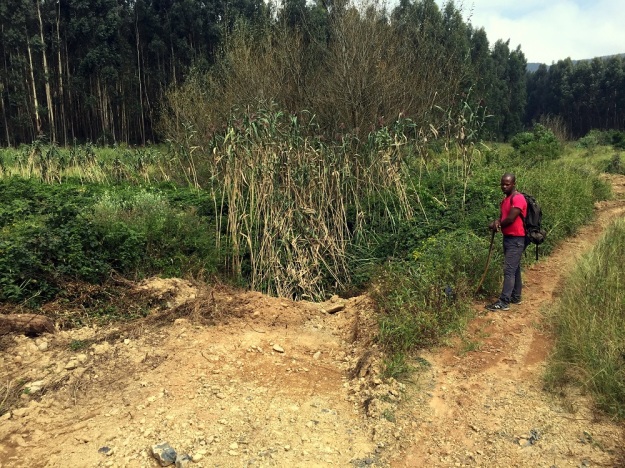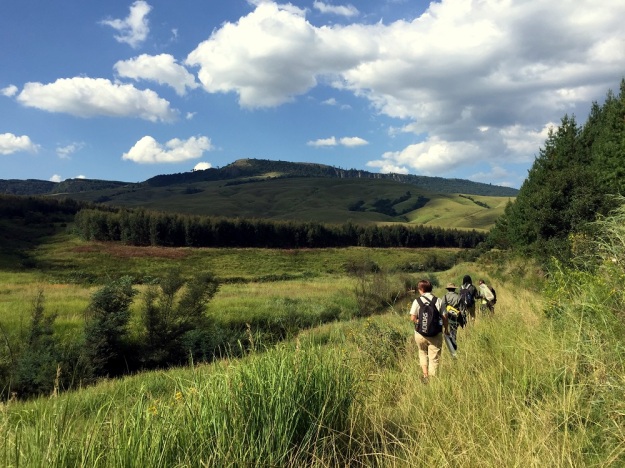Despite the occasional drizzle this summer, we have not had our usual rainfall. We are experiencing a drought as anyone who observes dam levels will have noticed. Can you imagine the state we would be in if frackers had contaminated our groundwater?
Prospecting licences to explore fracking options in KZN may not seem like such a great asset following the news that New York State has banned fracking. However, we still need to be on the alert as the opportunity to make some money in the short term is usually high on the agenda of mining companies.
The Midlands Conservancies Forum falls within a National Freshwater Ecosystem Priority Area. In order to determine the amount of shale gas present in the Midlands and its viability as an energy source, prospecting will need to take place. This activity has the potential to affect ground-water quality.
A collation of some recent articles about some of the issues that have hit the headlines recently, follows.
Fracking’s Critical Public Health Risk Factors – In total, more than 20 DOH senior research scientists, public health specialists, and radiological health specialists spent approximately 4,500 hours on the NY DOH Public Health Review of fracking risks. NY DOH examined fracking activities for possible human exposure to air and/or water contaminants; naturally occurring radiological materials resulting from fracking; and the effects of fracking operations on communities, such as noise, traffic, and other social changes. They also examined the likelihood of adverse public health outcomes from these exposures to fracking activities. Some of the environmental impacts and health outcomes identified in the review as potentially associated with fracking activities are:
- Air impacts that could affect respiratory health due to increased levels of particulate matter, diesel exhaust, or volatile organic chemicals.
- Climate change impacts due to methane and other volatile organic chemical releases to the atmosphere.
- Drinking water impacts from underground migration of methane and/or fracking chemicals associated with faulty well construction.
- Surface spills potentially resulting in soil and water contamination.
- Surface-water contamination resulting from inadequate wastewater treatment.
- Earthquakes induced during fracturing
- Community impacts associated with boom-town economic effects such as increased vehicle traffic, road damage, noise, odour complaints, increased demand for housing and medical care, and stress.

Increased production from US fracking operations is a major reason for the drop in oil prices, but there are warnings that the industry now faces a crisis. There’s no doubt that US-based fracking – the process through which oil and gas deposits are blasted from shale deposits deep underground – has caused a revolution in worldwide energy supplies. Yet now the alarm bells are ringing about the financial health of the fracking industry, with talk of a mighty monetary bubble bursting − leading to turmoil on the international markets similar to that in 2008. In many ways, it’s a straightforward case of supply and demand. Due to the US fracking boom, world oil supply has increased.
Glut in supplies But with global economic growth now slowing – the drop in growth in China isparticularly significant – there’s a lack of demand and a glut in supplies, leading to a fall in price of nearly 50% over the last six months.
Fracking has become a victim of its own success. The industry in the US has grown very fast. In 2008, US oil production was running at five million barrels a day. Thanks to fracking, that figure has nearly doubled, with talk of US energy self-sufficiency and the country becoming the world’s biggest oil producer – “the new Saudi Arabia” – in the near future.
The giant Bakken oil and gas field in North Dakota – a landscape punctured by thousands of fracking sites, with gas flares visible from space – was producing 200,000 barrels of oil a day in 2007. Production is now running at more than one million barrels a day. The theory is that OPEC is trying to drive the fracking industry from boom to bust
Fuelled by talk of the financial rewards to be gained from fracking, investors have piled into the business. The US fracking industry now accounts for about 20% of the world’s total crude oil investment. But analysts say this whole investment edifice could come crashing down.
Fracking is an expensive business. Depending on site structure, companies need prices of between $60 and $100 per barrel of oil to break even. As prices drop to around $55 per barrel, investments in the sector look ever more vulnerable. Analysts say that while bigger fracking companies might be able to sustain losses in the short term, the outlook appears bleak for the thousands of smaller, less well-financed companies who rushed into the industry, tempted by big returns he fracking industry’s troubles have been added to by the actions of the Organisation of Petroleum Exporting Countries (OPEC), which, despite the oversupply on the world market, has refused to lower production.
The theory is that OPEC, led by powerful oil producers such as Saudi Arabia, is playing the long game – seeking to drive the fracking industry from boom to bust, stabilise prices well above their present level, and regain its place as the world’s pre-eminent source of oil.
There are now fears that many fracking operations may default on an estimated $200 billion of borrowings, raised mainly through bonds issued on Wall Street and in the City of London. In turn, this could lead to a collapse in global financial markets similar to the 2008 crash.
Existing reserves
There are also questions about just how big existing shale oil and gas reserves are, and how long they will last. A recent report by the Post Carbon Institute, a not-for-profit thinktank based in the US, says reserves are likely to peak and fall off rapidly, far sooner than the industry’s backers predict. The cost of drilling is also going up as deposits become more inaccessible.
Besides ongoing questions about the impact of fracking on the environment − in terms of carbon emissions and pollution of water sources − another challenge facing the industry is the growth and rapidly falling costs of renewable energy.
Fracking operations could also be curtailed by more stringent regulations designed to counter fossil fuel emissions and combat climate change. Its backers have hyped fracking as the future of energy − not just in the US, but around the world. Now the outlook for the industry is far from certain. – Climate News Network

The Economist published an article entitled Sheiks vs Shale in December – a different take on the same issue. An extract:
In June the price of a barrel of oil, then almost $115, began to slide; it now stands close to $70 (ML – that was in December; now $47!). This near -40% plunge (ML – now nearly -60%!) is thanks partly to the sluggish world economy, which is consuming less oil than markets had anticipated, and partly to OPEC itself, which has produced more than markets expected. But the main culprits are the oilmen of North Dakota and Texas. Over the past four years, as the price hovered around $110 a barrel, they have set about extracting oil from shale formations previously considered unviable. Their manic drilling—they have completed perhaps 20,000 new wells since 2010, more than ten times Saudi Arabia’s tally—has boosted America’s oil production by a third, to nearly 9m barrels a day (b/d). That is just 1m b/d short of Saudi Arabia’s output. The contest between the shalemen and the sheikhs has tipped the world from a shortage of oil to a surplus.
There are signs that such a shake-out is already under way. The share prices of firms that specialise in shale oil have been swooning. Many of them are up to their derricks in debt. Even before the oil price started falling, most were investing more in new wells than they were making from their existing ones. With their revenues now dropping fast, they will find themselves overstretched. A rash of bankruptcies is likely. That, in turn, would bespatter shale oil’s reputation among investors. Even survivors may find the markets closed for some time, forcing them to rein in their expenditure to match the cash they generate from selling oil. Since shale-oil wells are short-lived (output can fall by 60-70% in the first year), any slowdown in investment will quickly translate into falling production.
This shake-out will be painful. But in the long run the shale industry’s future seems assured. Fracking, in which a mixture of water, sand and chemicals is injected into shale formations to release oil, is a relatively young technology, and it is still making big gains in efficiency. IHS, a research firm, reckons the cost of a typical project has fallen from $70 per barrel produced to $57 in the past year, as oilmen have learned how to drill wells faster and to extract more oil from each one. The firms that weather the current storm will have masses more shale to exploit. Drilling is just beginning (and may now be cut back) in the Niobrara formation in Colorado, for example, and the Mississippian Lime along the border between Oklahoma and Kansas. Nor need shale oil be a uniquely American phenomenon: there is similar geology all around the world, from China to the Czech Republic. Although no other country has quite the same combination of eager investors, experienced oilmen and pliable bureaucrats, the riches on offer must eventually induce shale-oil exploration elsewhere. The Economist
You are welcome to use the info-graphics included in the post as you wish. Should you prefer high resolution images, or others useful for use as email, Facebook or website banners, please email info@midlandsconservanciesforum.org.za and we will send them to you.
For more information and other interesting articles, see: http://www.midlandsconservancies.org.za/prpagefracking.php










































































